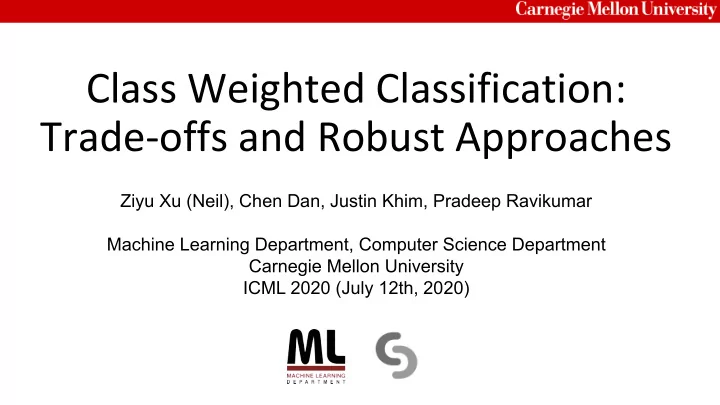

Class Weighted Classification: Trade-offs and Robust Approaches Ziyu Xu (Neil), Chen Dan, Justin Khim, Pradeep Ravikumar Machine Learning Department, Computer Science Department Carnegie Mellon University ICML 2020 (July 12th, 2020)
Problem We look at the class imbalance problem in machine learning, which comes up in applications such as e-commerce, object detection etc.
Contributions ● Fundamental trade-off for different weightings ● Formulation for robust risk on a set of weightings ● Stochastic programming solution to robust risk ● Statistical guarantees for generalization of robust risk (paper)
Organization ● Motivation and previous approaches ● Fundamental trade-off for different weightings ● Formulation for robust risk on a set of weightings ● Stochastic programming solution to robust risk
Class Imbalance The classes are very imbalanced... ~20x difference!
Is accuracy/risk a good measure? Example: 99% Microwave, 1% keyboard Classifier A: Predicts everything as microwave ● Accuracy: 99% ○ Classifier B: Classifies all keyboards correctly, 2% error on Microwave ● Accuracy: 98% ○
Previous Approaches: Data Augmentation ● SMOTE (Chawla et al. 2002) ● Under/oversampling (Zhou and Liu 2006) ● GANs (Mariani et al. 2018)
Previous Approaches: Alternative Metrics F1 Score Precision: proportion of minority class predictions that are correct Recall: proportion of true minority class samples that are predicted as minority class Poorly understood and may not be the desired metric
Class Weighting We formalize errors on different classes with class-conditioned risks.
Class Weighting Weighted risk is the weighted sum of the class-conditioned risks.
Class Weighting However, choosing weights is a difficult task: there are many hyperparameters to choose!
Example: Credit Card Fraud Avg cost of Mis-Classification $10 $100 Cost(fraud) = 10 ✕ Cost(non-fraud)
Example: Credit Card Fraud Avg cost of Mis-Classification $10 $100 Cost(fraud) = 10 ✕ Cost(non-fraud)
Class Weighting However, choosing weights is a difficult task: there are many hyperparameters to choose! What is the effect of choosing different weightings?
● Motivation and previous approaches ● Fundamental trade-off for different weightings ● Formulation for robust risk on a set of weightings ● Stochastic programming solution to robust risk
Fundamental Tradeoff Binary classification setup: Bayes optimal classifier:
Fundamental Tradeoff Plug-in estimator: Weighted excess risk:
Fundamental Tradeoff Region where differing predictions occur
Fundamental Tradeoff Region where differing predictions occur Optimizing for one weighting inevitably reduces performance on another
● Motivation and previous approaches ● Fundamental trade-off for different weightings ● Formulation for robust risk on a set of weightings ● Stochastic programming solution to robust risk
Robust Weighting Define Q as a set of weightings - we define a robust risk as the maximum weighted risk over Q :
● Motivation and previous approaches ● Fundamental trade-off for different weightings ● Formulation for robust risk on a set of weightings ● Stochastic programming solution to robust risk
Label CVaR The result is label CVaR (LCVaR) , a new optimization objective based on a specific robust weighted risk.
Label CVaR The result is label CVaR (LCVaR) , a new optimization objective based on a specific robust weighted risk. Each weight has a selected upper bound. Must be a probability.
LHCVaR Since different classes have different sizes, we can also use different maximum weights. We call this version label heterogeneous CVaR (LHCVaR), since the label weights are not necessarily uniform like in LCVaR
CVaR This type of robust problem has been studied in portfolio optimization. One formulation is the ɑ conditional value-at-risk (CVaR), which is the average loss conditional on the loss being above the (1 - ɑ)-quantile.
CVaR Main idea: instead of optimizing the worst ɑ-proportion of losses in a portfolio, achieve good accuracy on the worst ɑ-proportion of class labels.
Optimization The connection to CVaR presents us with a dual form, that allows for minimization over all variables.
Conclusions ● Minimizing LCVaR/LHCVaR enables good performance all weightings, rather than on a single weighting. ● LCVaR require fewer user tuned parameters. ● LCVaR/LHCVaR have dual forms that can be optimized efficiently.
Thank you!
Main equations LCVaR:
Main equations LHCVaR:
Fundamental Trade-off Summary
Hyperparameter tuning for LHCVaR Recall that LHCVaR is the heterogeneous version of our loss i.e. we can choose a different alpha for each class. That means the number of hyperparameters scale w/ the number of classes, which is scary.
Hyperparameter tuning for LHCVaR It seems somewhat reasonable to choose alphas inversely proportional to the the class proportions: Temperature parameter: As kappa goes to infinity, the alphas become closer to uniform As kappa goes to 0 - the sharper the alphas become. Acts as upper bound on any alpha
Dual form optimization tricks Note that the dual form is non-smooth, which actually makes gradient descent a little inefficient in this case, but we can explicitly calculate lambda at each step:
Dual form optimization tricks Dual objective:
Numerical validation
Experimental Evaluation ● Synthetic dataset, in which we simulate large class imbalance for binary classification. ● A real dataset from the UCI dataset repository, which has multiclass class imbalance. In our experiments, we use a logistic regression model.
Synthetic Experiment We generate a binary classification dataset, where we vary probability of class 0, the majority class.
Synthetic Experiment Risk on majority class Risk on minority class LCVaR/LHCVaR beats balanced on majority class, and standard on minority class.
Synthetic Experiment Worst case risk And consequently has increasingly better worst case risk as imbalance increases.
Real Data Experiment Covertype dataset: https://archive.ics.uci.edu/ml/datasets/covertype 54-dimension feature set. 7 labels.
Real Data Experiment Balanced (0.5333) Standard (0.5111) LCVaR (0.5037) LHCVaR ( 0.4907 ) LHCVaR/LCVaR have the best worst case class risk
Recommend
More recommend